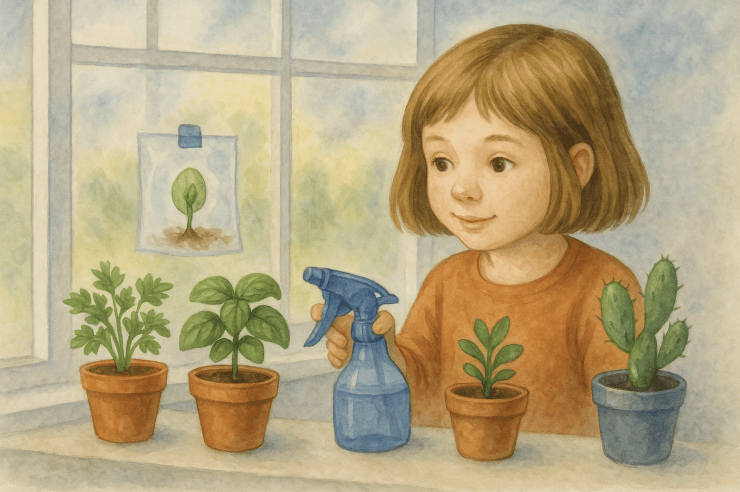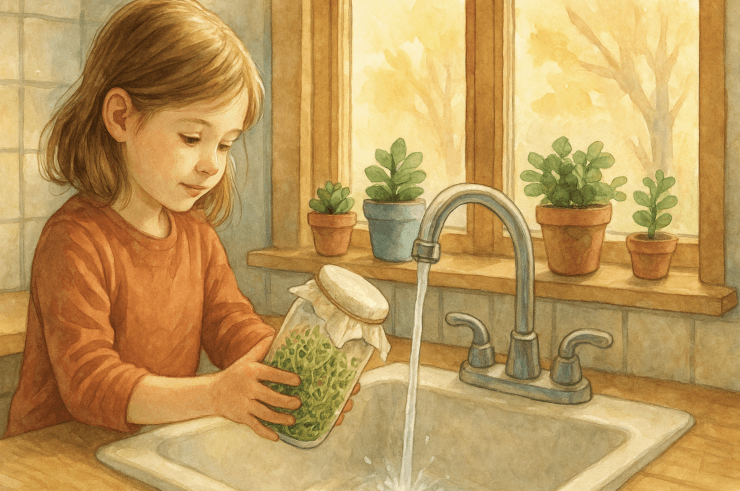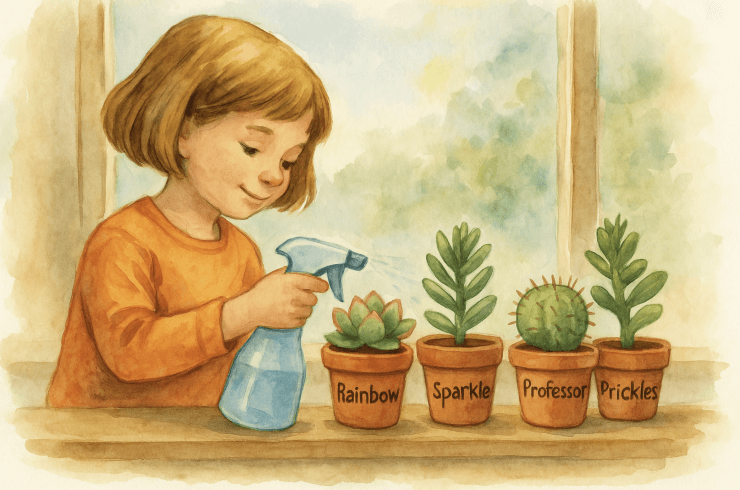Read by Matilda Longbottom

There’s a special kind of desperation that sets in around mid-January when you’re parenting a seven-year-old. The holiday decorations come down, revealing the sad reality of your living room. The sun sets at approximately 4:47 PM. Your child has the restless energy of a caged raccoon, and you find yourself seriously considering whether starting a windowsill garden counts as quality time.
Spoiler alert: It absolutely does. And last Winter, it might just have saved my sanity.
The Great Indoor Growing Epiphany
My windowsill gardening journey began on a particularly bleak February afternoon. My daughter stood at the window, staring into the gray void, and announced with the weight of an existential philosopher: “Mom, I miss green things.”
Same, kid. Same.
That’s when I remembered that plants don’t actually hibernate for Winter like reasonable creatures. They just need a little help from their friends (that’s us, the desperate parents seeking any activity that doesn’t involve screens or the phrase “I’m bored” repeated forty-seven times).
Getting Started: The Essentials (No Judgment Zone)
Before I dive into the specific projects we tried, let’s talk about what you actually need. And by “need,” I mean the bare minimum to get green things growing without a special trip to three different garden centers.
The Basic Shopping List:
- Potting soil (the kind specifically for containers – drainage matters)
- Small containers with drainage holes (or regular containers and a drill if you’re feeling ambitious)
- Seeds or starter plants
- A south-facing window (or the sunniest spot you’ve got)
- A spray bottle for watering (because seven-year-olds + full watering cans = indoor floods)
My daughter and I raided the dollar store, the recycling bin, and hit the garden center for soil and seeds. Total investment: about $25 and one minor tantrum in the seed section when I explained we couldn’t grow watermelons on the windowsill.

Project #1: The Foolproof Herb Garden
Why Start Here: Herbs grow relatively fast, smell amazing, and give kids the thrill of growing something you can actually eat. Plus, fresh basil in February feels like winning the lottery.
What You’ll Need:
- Small pots (4–6 inches)
- Potting soil
- Seeds or starter plants: basil, parsley, and chives (the holy trinity of “hard to kill”)
How We Did It:
Day one involved more soil on the floor than in the pots, but we survived. My daughter took her role as Head Seed Planter with the seriousness of a surgeon. We planted basil, parsley, and chives in separate pots, labeled them with popsicle stick markers (that she decorated with enough glitter to qualify as a biohazard), and placed them on the kitchen windowsill.
The Actual Instructions:
- Fill pots about 3/4 full with potting soil
- If using seeds: sprinkle 2–3 seeds on top, cover lightly with soil (about 1/4 inch)
- Spray with water until moist but not swimming
- Place in your sunniest window
- Keep soil moist (we checked daily – it became our morning ritual)
- Seeds should sprout in 5–10 days
Real Talk: The basil grew like it was personally offended by Winter. The parsley took forever but eventually showed up fashionably late to the party. We only had one casualty when I forgot to water for three days straight during a work deadline, but overall, I’m counting it as a parenting win.
The magic moment came about a week later when we spotted the first tiny green shoots. My daughter reacted like she’d witnessed actual sorcery. We checked the herbs before breakfast every morning – a routine that somehow got her out of bed more effectively than my increasingly creative threats about missing the school bus.

Project #2: The Three-Day Sprout Miracle
Why This Works: Instant gratification for kids who think waiting until tomorrow is an eternity. Also, it involves playing with food, which is always a hit.
What You’ll Need:
- A clean glass jar
- Sprouting seeds (alfalfa, broccoli, or mung beans work great)
- Cheesecloth and a rubber band
- Water
- A place away from direct sunlight
The Process:
- Put 2 tablespoons of seeds in your jar
- Cover with water and let soak overnight
- Drain in the morning, cover jar with cheesecloth and rubber band
- Rinse and drain the seeds twice daily (morning and night)
- Watch the magic happen
Within three days, we had actual sprouts we could eat. My daughter was suspicious at first (“Mom, this looks weird”), but adding them to sandwiches gave her serious culinary authority at the lunch table. She spent weeks telling anyone who would listen that she “grew her own salad.”
Pro Tip: This project teaches responsibility without the high stakes of “we killed another living thing.” If you forget to rinse them once, the world doesn’t end.

Project #3: The Bean Observation Laboratory
Why It’s Perfect: You can literally watch the whole life cycle happen. It’s like nature’s reality TV show, but without the manufactured drama.
What You’ll Need:
- Dried bean seeds (lima or pinto work great)
- Paper towels
- A clear plastic bag or glass jar
- Tape
- Your sunniest window
The Setup:
- Dampen (not soak) a few paper towels
- Place 2–3 beans on the towels
- Fold the towels over the beans
- Put everything in a clear plastic bag or jar
- Tape to a sunny window
- Check daily and re-moisten if needed
My daughter checked on her beans approximately every four minutes for the first two days. “Is it growing yet?” became our household mantra, replacing “When’s dinner?” and “Can I have more screen time?”
Then one morning – BOOM. A tiny white root breaking through the bean’s skin. The shrieking that ensued probably concerned the neighbors, but it was worth every moment of “Is it growing yet?”
We documented everything with photos and drawings. My refrigerator looked like evidence from a botanical crime scene for months, but she learned about roots, shoots, leaves, and the plant life cycle without a single worksheet. Science teachers everywhere would be proud (or horrified by our methods – hard to say).

Project #4: The Low-Stakes Succulent Station
Why This Matters: For those inevitable moments when you realize you’ve forgotten to water everything for four days straight and need plants that will actually forgive you.
What You’ll Need:
- Small succulents (hit the clearance section – these guys bounce back)
- Cactus/succulent potting mix
- Small pots with drainage
- Rocks or pebbles (optional but fun for decorating)
The Method:
- Fill pots with succulent soil
- Plant your succulents
- Water lightly once a week (mark it on your calendar, seriously)
- Place in bright light
- Watch your child become unreasonably attached to a spiky plant named “Steve”
My daughter insisted on naming ours. We ended up with “Rainbow,” “Sparkle,” and “Professor Prickles.” The beauty of succulents is they teach kids that sometimes the best care is benign neglect. Profound life lesson? Probably. Also just convenient parenting? Absolutely.
The Unexpected Benefits Nobody Warned Me About
Here’s what actually happened during our Winter windowsill garden adventure that went beyond the simple goal of “something green to look at”:
Morning Routines That Didn’t Involve Arguing: Instead of the usual breakfast negotiation warfare, we checked on the plants together. She actually got out of bed willingly to see if anything new had sprouted. WILLINGLY. Let that sink in.
Sneaky Educational Moments: We measured growth, counted leaves, tracked days until germination – it was all math and science happening naturally. No worksheets, no tears, just genuine curiosity about what would happen next.
Something to Care For: She watered her plants, talked to them (apparently they liked to hear about second-grade drama), and developed a genuine sense of responsibility that didn’t involve the emotional guilt of pet ownership.
Actual Food We Grew and Ate: The moment she tried a sprig of basil she’d grown herself and declared it “way better than the store kind” was worth every grain of spilled potting soil.
What Kept Us Connected
Windowsill gardening last Winter wasn’t really about the plants – though the fresh herbs in February were a nice bonus that made me feel unreasonably smug at the grocery store. It was about creating these small moments of growth and life when everything outside looked dormant and dead.
It was standing together at the window each morning, checking for new leaves with genuine excitement. It was her explaining photosynthesis to her stuffed animals because she was so proud of what she’d learned. It was the way she started noticing plants everywhere we went, pointing out herbs at restaurants and asking if we could grow “that one with the purple flowers.”
And yes, we had casualties. Something mysterious happened to one basil plant that I’m blaming on aphids (probably overwatering). Professor Prickles looked suspiciously brown on one side by March (definitely underwatering). But we learned together – about plants, about patience, about how growth takes time even when you really, really want it to hurry up.
The best part? Those quiet mornings standing at the windowsill together, watching tiny green things push through soil, reminded both of us that even in the darkest, coldest, most cabin-fever-inducing days of Winter, something beautiful can still grow.
Worth it? Absolutely. Would I do it again? Already planning this Winter’s lineup, complete with a few new varieties and slightly better soil management. Because if we’re going to survive February together, we might as well do it with fresh herbs, questionable plant names, and a windowsill full of green reminders that Spring always comes eventually.
Even if it takes its sweet time getting here. ❖


 Previous
Previous


